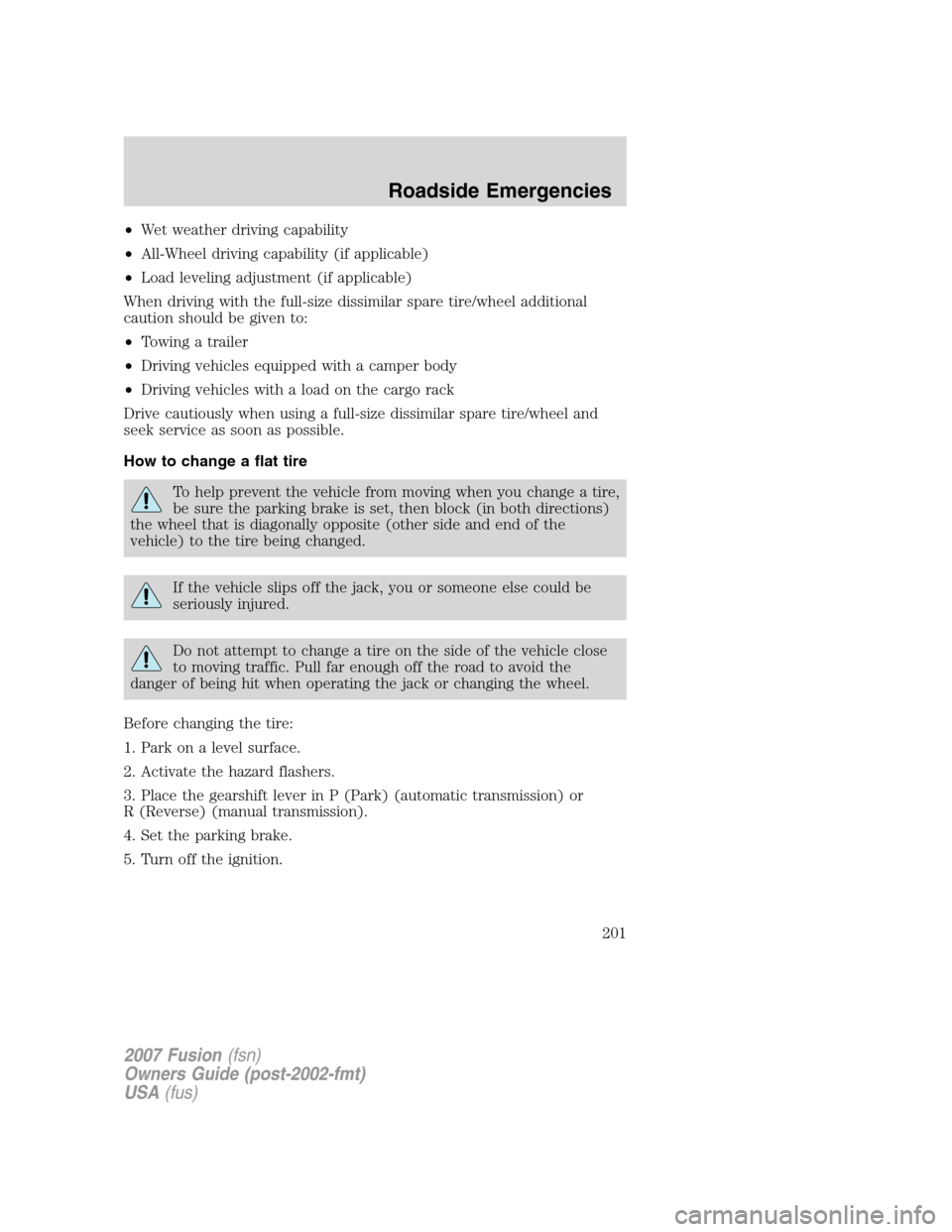Page 201 of 280

•Wet weather driving capability
•All-Wheel driving capability (if applicable)
•Load leveling adjustment (if applicable)
When driving with the full-size dissimilar spare tire/wheel additional
caution should be given to:
•Towing a trailer
•Driving vehicles equipped with a camper body
•Driving vehicles with a load on the cargo rack
Drive cautiously when using a full-size dissimilar spare tire/wheel and
seek service as soon as possible.
How to change a flat tire
To help prevent the vehicle from moving when you change a tire,
be sure the parking brake is set, then block (in both directions)
the wheel that is diagonally opposite (other side and end of the
vehicle) to the tire being changed.
If the vehicle slips off the jack, you or someone else could be
seriously injured.
Do not attempt to change a tire on the side of the vehicle close
to moving traffic. Pull far enough off the road to avoid the
danger of being hit when operating the jack or changing the wheel.
Before changing the tire:
1. Park on a level surface.
2. Activate the hazard flashers.
3. Place the gearshift lever in P (Park) (automatic transmission) or
R (Reverse) (manual transmission).
4. Set the parking brake.
5. Turn off the ignition.
2007 Fusion(fsn)
Owners Guide (post-2002-fmt)
USA(fus)
Roadside Emergencies
201
Page 202 of 280
Removing the spare tire and jack
1. Remove the carpeted load floor
panel located in the rear of the
vehicle and remove the lug wrench
and long bolt from the tool bag.
2. Remove the bolt securing the
spare tire using the lug wrench,
then lift and remove the spare tire
from the trunk.
3. Remove the jack retention bolt by
turning it counterclockwise and
remove the jack from the vehicle.
Tire change procedure
Note:Passengers should not remain in the vehicle when the vehicle is
being jacked.
1. Block both the front and rear of
the wheel diagonally opposite the
flat tire. For example, if the left
front tire is flat, block the right rear
wheel.
2007 Fusion(fsn)
Owners Guide (post-2002-fmt)
USA(fus)
Roadside Emergencies
202
Page 257 of 280

1. Start the engine and let it run until it reaches normal operating
temperature (the engine coolant temperature gauge indicator will be
near the center of the normal area between H and C).
2. While the engine idles, turn the steering wheel left and right several
times.
3. Turn the engine off.
4. Check the fluid level in the reservoir. It should be between the
MIN/MAX or upper and lower lines. Do not add fluid if the level is in this
range.
5. If the fluid is low, add fluid in small amounts, continuously checking
the level until it reaches the range between the MIN/MAX or upper and
lower lines. Be sure to put the cap back on the reservoir.
BRAKE/CLUTCH FLUID
Brake and clutch systems are supplied from the same reservoir.
The fluid level will drop slowly as
the brakes wear, and will rise when
the brake components are replaced.
Fluid levels between the “MIN” and
“MAX” lines are within the normal
operating range; there is no need to
add fluid. If the fluid levels are
outside of the normal operating
range the performance of the
system could be compromised; seek
service from your authorized dealer
immediately.
TRANSAXLE FLUID
Checking 5–speed automatic transaxle fluid (If equipped)
Refer to yourscheduled maintenance informationfor scheduled
intervals for fluid checks and changes. Your transaxle does not consume
fluid. However, the fluid level should be checked if the transaxle is not
working properly, i.e., if the transaxle slips or shifts slowly or if you
notice some sign of fluid leakage.
Automatic transmission fluid expands when warmed. To obtain an
accurate fluid check, drive the vehicle until it is warmed up
(approximately 20 miles [30 km]). If your vehicle has been
MAX
MIN
2007 Fusion(fsn)
Owners Guide (post-2002-fmt)
USA(fus)
Maintenance and Specifications
257
Page 276 of 280

Engine oil ..................................232
change oil soon warning,
message center .......................232
checking and adding ..............232
dipstick ....................................232
filter, specifications ........236, 264
recommendations ...................236
refill capacities ........................266
specifications ..........................266
Exhaust fumes ..........................173
F
Fail safe cooling ........................244
Fluid capacities .........................266
Foglamps .....................................50
Four-Wheel Drive vehicles
driving off road .......................184
Fuel ............................................245
calculating fuel
economy ............................76, 250
cap ...........................................247
capacity ...................................266
choosing the right fuel ...........248
comparisons with EPA
fuel economy estimates .........253
detergent in fuel .....................249
filling your vehicle
with fuel ..................245, 247, 250
filter, specifications ........245, 264
fuel pump shut-off switch .....192
improving fuel economy ........250
octane rating ...................249, 269
quality ......................................249
running out of fuel .................249
safety information relating
to automotive fuels ................245
Fuel pump shut-off switch .......192
Fuses ..................................192–193G
Gas cap (see Fuel cap) ............247
Gas mileage
(see Fuel economy) .................250
Gauges .........................................14
H
Hazard flashers .........................191
Head restraints .........................101
Headlamps ...................................49
aiming ..................................51–52
autolamp system .......................49
bulb specifications ....................54
daytime running lights .............50
flash to pass ..............................51
high beam .................................51
replacing bulbs .........................54
turning on and off ....................49
Heating
heating and air conditioning
system ...........................41, 43, 45
Hood ..........................................228
How to get going ........................17
I
Ignition ...............................170, 269
Illuminated visor mirror .............64
Infant seats
(see Safety seats) .....................140
Inspection/maintenance (I/M)
testing ........................................255
Instrument panel ........................66
cleaning ...................................223
cluster ........................................10
lighting up panel and
interior .......................................51
2007 Fusion(fsn)
Owners Guide (post-2002-fmt)
USA(fus)
Index
276